Dalai Lama and RSS: Strengthening spiritual relationship
Virag Pachpore
RSS thinks not just for India but for the entire world: H E Dalai Lama
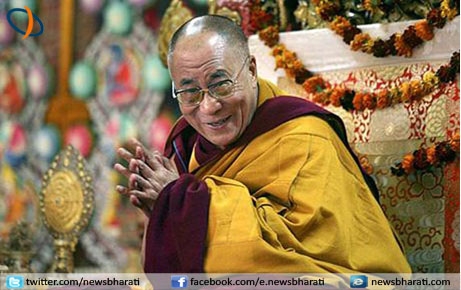 Tibetan spiritual Guru, the 14th Dalai Lama, is completing 80 years of life full of eventualities, spiritual wisdom and spreading the message of global peace. The International Centre of Spiritual and Ancestral Wisdom, Sedona, Arizona, USA is celebrating his birthday as “Global Compassion Summit” on July 6, 2015. H E Dalai Lama has a very long and fruitful association with Rashtriya Swayamsevak Sangh (RSS). Here an attempt is made to trace that relationship and how it is strengthening the spiritual-cultural bonds between the Buddhists and Hindus. - Editor
Tibetan spiritual Guru, the 14th Dalai Lama, is completing 80 years of life full of eventualities, spiritual wisdom and spreading the message of global peace. The International Centre of Spiritual and Ancestral Wisdom, Sedona, Arizona, USA is celebrating his birthday as “Global Compassion Summit” on July 6, 2015. H E Dalai Lama has a very long and fruitful association with Rashtriya Swayamsevak Sangh (RSS). Here an attempt is made to trace that relationship and how it is strengthening the spiritual-cultural bonds between the Buddhists and Hindus. - Editor
Tibet is a very strategically located region situated at the topmost plateau of Asia to the northeast of the Himalayas. Ancient Sanskrit texts often describe Tibet as “Trivishtap” and ‘Home of Gods’. The region used to be a buffer between China and India until the Chinese under Mao Zedong used brute force to occupy this beautiful land of peace loving followers of “Avalokiteshwara” the Buddha.
The Tibetan tradition: Dalai Lama, is a tradition of the Tibetan Buddhists. The person nominated as Dalai Lama happens to be their spiritual and temporal head. The present Dalai Lama is the 14th in the tradition and happens to be longest living spiritual head of the Tibetans.
The present Dalai Lama, whose original name is Tenzin Gyatso, shortened from Jetsun Jamphel Ngawang Lobsang Yeshe Tenzin Gyatso, was born as Lhamo Dondrub on 5 July 1935 is the longest-lived incumbent. Dalai Lamas are important monks of the Gelug School. He was honored with the Nobel Peace Prize in 1989, and is known for his heartfelt advocacy for Tibetans worldwide and his lifelong interest in modern science.
As per the tradition, at the age of two, he was selected as the successor of the 13th Dalai Lama in 1937 and formally recognized as the 14th Dalai Lama at a public declaration near the town of Bumchen in 1939. His enthronement ceremony as the Dalai Lama was held in Lhasa on February 22, 1940 and he eventually assumed full temporal (political) power over Tibet on 17 November 1950, at the age of 15, after China's invasion of Tibet.
During the 1959 Tibetan uprising, the Dalai Lama fled to India, where he currently lives as a refugee. He has since traveled the world, advocating for the welfare of Tibetans, teaching Tibetan Buddhism, investigating the interface between Buddhism and science and talking about the importance of compassion as the source of a happy life. Around the world, institutions face pressure from China not to accept him.
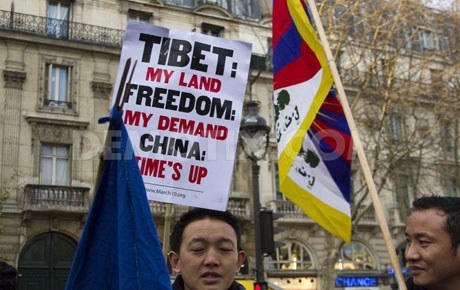
The Panchsheel & sacrifice of Tibet: Before the Chinese invasion, Tibet was an independent, neighboring state. Even during the British rule they did not disturb the autonomous status of Tibet. The deceptive ‘Panchasheel’ agreement between Indian Premier Pt. Jawahar Lal Nehru and his Chinese counterpart Zhou-en-Lai, and failure of the Indian leadership to fathom the imperialist and expansionist attitude of China led to sacrifice of Tibet. The Chinese Red Army pounced on Tibet, launching a ‘Cultural Revolution’ under the leadership of Mao Zedong. For nearly 26 years since China forcibly occupied Tibet in 1949, the Tibetans were subjected to horrific, inhuman tortures; killings forcing them flee their homeland and take refuge in the neighboring India. The Chinese deliberately settled the Han and Hui Chinese people and married them forcibly with the Tibetan Buddhists women so that the region would become a Chinese majority region in future.
The Chinese invasion caused deaths to thousands of Tibetans as they attempted to flee from the People’s Liberation Army. Thousands were deported to labor camps to die. During the Cultural Revolution, Mao Zedong encouraged people to destroy the “Four Old”: old customs, habits, beliefs and ideas. The Cultural Revolution plunged Tibet into the deepest hell.
The Cultural Revolution ended with Mao Zedong’s death in 1976. By the end of the Cultural Revolution more than 6,000 monasteries had been destroyed, only 12 were left standing. In short, Mao attempted to take the Buddha’s place as ‘god’ in Tibet. This was reinforced many years later by Zhang Qingli, the former controversial hard line party secretary of Tibet Autonomous Region who had said in 2008 that the “Chinese Communist Party (CCP) is the real Buddha for Tibetans.”
Seeking refuge in India: Repeated attempts by The Dalai Lama to negotiate with China were dismissed. In 1950, the 15-year-old Dalai Lama was forced into full leadership of Tibet, while in 1951 a Tibetan Delegation was compelled to sign the 17-Point Agreement, promising "Measures for the Peaceful Liberation of Tibet." During 1959, The Dalai Lama went to China to speak with Chairman Mao Zedong. Mao told him, "Religion is poison. ... Tibet and Mongolia have both been poisoned by it." During this year the Chinese retaliated against the Tibetan resistance, killing more than 87,000. On March 17, 1959, The Dalai Lama escaped his sacred homeland, seeking political asylum in India. The Chinese declared martial law as thousands of Tibetan refugees begin pouring into India.
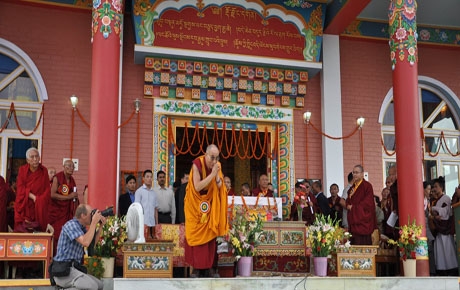
After his arrival in India the Indian government settled the Tibetan Buddhists at Dharamshala in Himachal Pradesh and elsewhere in the country. Dalai Lama has set up his Government in Exile there. He has since traveled the world, advocating for the welfare of Tibetans, teaching Tibetan Buddhism, investigating the interface between Buddhism and science and talking about the importance of compassion as the source of a happy life. Around the world, institutions face pressure from China not to accept him.
The policy of the Dalai Lama until he retired from the Central Tibetan Administration was that he did not seek sovereignty for Tibet, but would accept Tibet as a genuine autonomous region within the People's Republic of China. He has spoken about the environment, economics, women's rights, non-violence, interfaith dialogue, physics, astronomy, Buddhism and science, cognitive neuroscience, reproductive health, and sexuality, along with various Mahayana and Vajrayana topics.

Tibet issue and the RSS: The Second Sarsanghchalak of RSS M S Golwalkar alias Guruji was probably the first leader after Swami Vivekananda to forewarn the Indian leadership about the expansionist designs of Communist China vis-à-vis Tibet. But he was criticized by the media as ‘Warmonger’. However later day events proved how prophetic Golwalkar was! The Indian government was caught completely off the guard and the Chinese Red Army marched into Indian Territory of NEFA, and Laddakh crossing the mighty Himalayan ranges after swallowing Tibet. Since then, the RSS has not only been sympathetic to the cause of the Tibetans and independence of Tibet but also supported them in every aspect.
The RSS concerns over Tibet & China: Thus began the association between Tibetans and their leaders and the RSS which championed the cause of Hindutva and considered Buddhism as an offshoot of the Hindu philosophy. The Tibetans, especially the Dalai Lama never hid his tremendous reverence for India and Hindu traditions and philosophy.
The RSS Akhil Bharatiya Karyakari Mandal (ABKM) in their 1959 meeting passed a resolution on “Bharat’s policy vis-à-vis Chinese aggression. The resolution said: “The Government in their anxiety to befriend China became totally unmindful of her expansionist designs and even admitted China's claims over Tibet without a murmur of protest. Consequently, Tibet, which for centuries had been bound with Bharat with close cultural ties, has not only lost her independence but ceased to act as a buffer between Bharat and China, thereby enabling Chinese forces to be poised right on our borders.” (http://www.archivesofrss.org/Resolutions.aspx)
Again in 1962 after the Chinese invasion the RSS ABKM adopted a resolution stressing on Tibet’s liberation. The resolution said: “Besides liberation of Indian Territory, Tibet's freedom is also a must, if China's expansionism is to be contained and the right of all nations to a free existence is to be upheld, and permanent security of India's borders is to be assured. Communist China has violated all her pledges regarding Tibet. India can, in her right, and is in fact duty-bound to, lend all possible help to Tibet's liberation movement. Diplomatic relations with Communist China are not therefore consistent with the present state of affairs. These ties should be immediately severed.” (http://www.archivesofrss.org/Resolutions.aspx)
In 2012 ABKM meeting coinciding the 50th anniversary of Chinese invasion of India, the RSS again highlighted the Tibet issue warning the people against Chinese designs and stressing for a “comprehensive national security policy vis-à-vis China.
(http://www.archivesofrss.org/Resolutions.aspx)
Dalai Lama-RSS association: The RSS, Vishwa Hindu Parishad (VHP) leaders developed close contacts with Dalsi Lama and his close associates and probably the first public sharing of dais with RSS leaders and Dalai Lama took place in 1979. The VHP had organized the Second World Hindu Congregation at Prayag in that year and requested the Dalai Lama to inaugurate the same. The then Sarsanghchalak of RSS Balasaheb Devras attended that event.
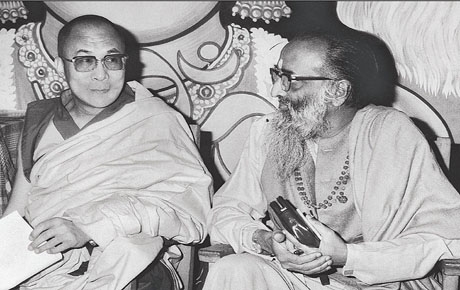
In his address Dalai Lama said: “Someone may feel my presence in this Sammelan awkward. But when seen liberally, it is not impertinence, because, the Hindus and adherents of all those Bharat-originated religions are participating in this Sammelan. The Buddhism evolved in Tibet is, in fact, a Bharatiya religion originally propounded by Lord Buddha himself. It could not remain secure in the land of its birth. We have not only kept it secure till today, but developed it further.
“After having a discussions with the intellectuals of Bharat, I felt that there is no difference, whatsoever, between them and us either on the basis of philosophy or practice. The entire treasure accumulated with us for past millennia originally belongs to Bharat only. The principal aim of all religions is to rid the living beings from their grief, misery and sorrow. Their paths may be different; but their goal is to bestow peace and happiness upon all. Hence, if all adherents of Bharat-based religions come together with the aspiration for working to attain happiness and welfare of all; then it is absolutely relevant and necessary too. That’s why I heartily feel a sense of delight while participating in this Sammelan.
“This Vishwa Hindu Sammelan is a historic event by itself. The significance of this step would further enhance, if a bold step is taken to remove all the irrelevancies that have crept into all the Bharat-based religions; when all the adherents of religions would organise on the basis of mutual good-will; and pave the way of peace and happiness for all the beings by repelling the sorrows like world-gripping fear, inequality, slavery and exploitation etc. I pray the Triratnas for the success of this cause”. (http://vhp.org/conferences/world-hindu-conference/world-hindu-conference-2-whc-ii)
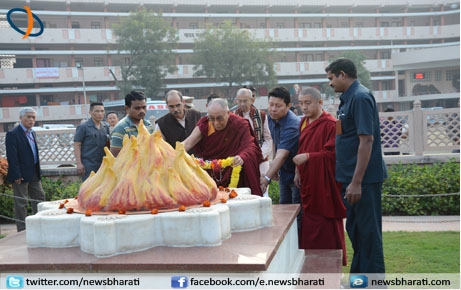
Dalai Lama praises RSS: The Dalai Lama, defying all the restrictions to change his itinerary paid a visit to RSS headquarters in Nagpur on January 10, 2014. The RSS top leaders were away from Nagpur in a meeting at Hyderabad then. The Tibetan Spiritual leader was received by local RSS leaders and taken to the memorial of RSS founder Dr K B Hedgewar and his successor Golwalkar Guruji at Reshambag premises.
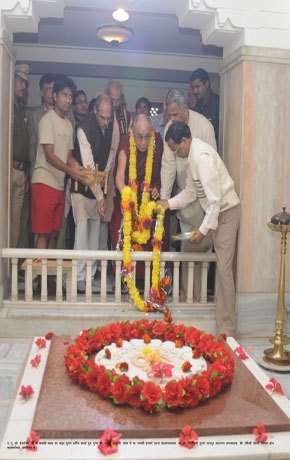
After paying homage to the leaders, interacting with media people he praised the RSS for its support to the Tibetan cause. Dalai Lama recalled his association with VHP leader Ashok Singhal and former RSS Sarsanghchalak K S Sudarshan stating that the RSS was working in India with dedication similar to ours in Tibet. “RSS has always supported the cause of Tibet and hence I always have love for it” he said adding “RSS thinks not just for India but for the entire world”. (http://indianexpress.com/article/india/rss-has-done-good-work-towards-promoting-the-values-of-dedication-dalai-lama/#sthash.lSZGQoQX.dpuf)
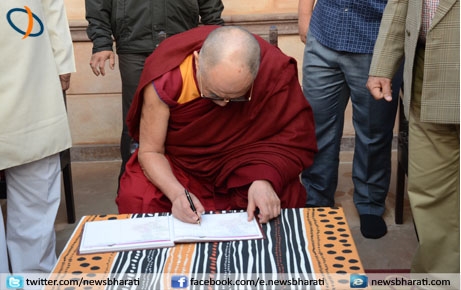
However, he could not meet RSS Chief Dr Mohan Bhagwat as the latter was away from Nagpur. But both had telephonic conversation. Dr Bhagwat said: “India and Tibet have spiritual connection and both countries believe in welfare of people.’ Bhagwat also assured Dalai Lama that, “Sangh will always remain with Tibetan people in their struggle”.
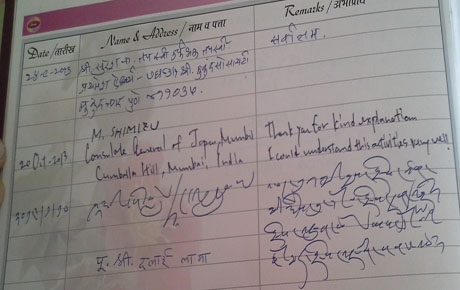
Interaction with RSS leaders: According to The Tibet Post International, Indresh Kumar, senior RSS leader used to meet Dalai Lama. The one such meeting was held on May 26, 2011 in which Indresh Kumar discussed the current situation in Tibet with the Tibetan Spiritual Leader.
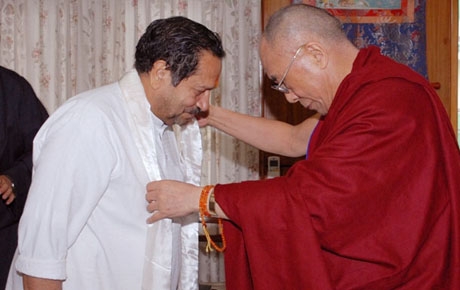
Indresh Kumar, who is instrumental in formation of ‘Bharat-Tibet Sahayog Manch’ an organization to facilitate friendship, understanding and mutual cooperation between the Tibetan people and Indians, later met the newly elected Prime Minister of the Government of Tibet in Exile Dr Lobsang Sangay and congratulated him for his victory.
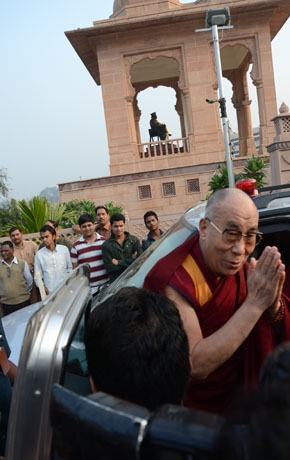
Dalai Lama also opened the annual conference of Akhil Bharatiya Vidyarthi Parishad (ABVP) at Kanpur and Dharmasala in the 90s. The ABVP was actively involved in canvassing for a free Tibet and is also in contact with the Tibetan Youth Congress, a March 12, 1999 report in rediff.com said.
The former Prime Minister of the Government of Tibet in Exile Prof Samdong Rinpiche was the chief guest for the RSS annual Vijayadashmi celebrations. The then RSS chief K S Sudarshan had invited him and he accepted the invitation. Prof Rinpoche also attended the inaugural ceremony of the third International Conference of the Elders of the Ancient Traditions of the World organized by the RSS-sponsored International Centre for Cultural Studies (ICCS) at Nagpur in 2009. Similarly, the incumbent PM Dr Lobsang Sangay had shared dais with K S Sudarshan at a seminar organised by Makhanlal Chaturvedi Journalism University, Bhopal a couple of years ago.
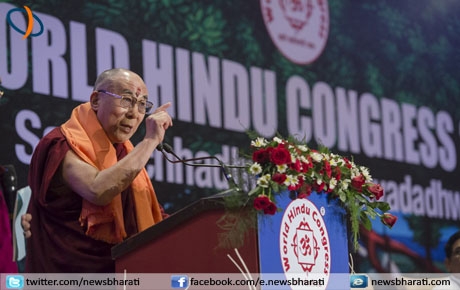
Dalai Lama and WHC: The most recent incident to highlight this association was the World Hindu Congress (WHC) held last year in New Delhi. The WHC was organized with the support of VHP and RSS and Dalai Lama inaugurated it along with RSS chief Dr Mohan Bhagwat and VHP stalwart Ashok Singhal. Dalai Lama said that India should remember and reinforce its great tradition of tolerance and religious harmony…. Dalai Lama credited India for all the knowledge that Tibet and Buddhists have saying that ancient India was their guru. “Ancient India was our guru. Not modern India, it is too westernised….It is not enough to carry on puja and rituals. This nation produced great thinkers. Now in every corner there is a temple. But places where one can think or discuss are rare”, he said. Referring to Chinese practice of forming ‘China Towns’ wherever they go, Dalai Lama expected from RSS that India should aim to form “India Towns” across the world where they must open cultural centres instead of temples and “talk about ahimsa and religious harmony”.
The RSS Chief Dr Mohan Bhagwat who spoke after Dalai Lama described him as “human being who sees unity in every diversity”.
Dalai Lama was felicitated at the World Hindu Congress. The citation of the honour described the Dalai Lama as a manifestation of Avalokiteshvara, the Bodhisattva of Compassion, as someone who has already been awarded the Nobel Peace Prize and the Magaysay Award, who has established schools, monasteries and institutions such as the Library of Tibetan Works & Archives and who has propagated the Dharma of truth and compassion.
In his address to the gathering of 1800 delegates from 50 countries, the Dalai Lama spoke of Buddhism and Hinduism as being like spiritual brothers. He reiterated that all major religious traditions teach compassion, forgiveness and self-discipline. He added that the goal of all the different religious traditions was to benefit humanity. He remarked that despite philosophical differences between them, he viewed all major religious traditions as being conducive to peace of mind. “We are all equal. Born the same way. Sometimes we forget the sameness of humanity and talk of divisions. In terms of we and they… We need sense of oneness among seven billion people of the world”.
(http://www.tibetanreview.net/dalai-lama-honoured-at-inaugural-global-hindu-meet/)
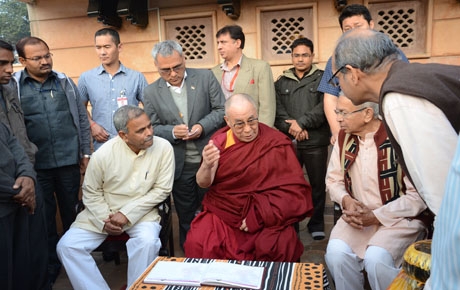
Such a great leader, a living legend of peace and brotherhood, non-violence and love is amongst us guiding the humanity for better future. Let us pray for his long, healthy and inspiring life on the occasion of 80th birthday. His inspiring words will no doubt further strengthen the spiritual and cultural relations between the Tibetan Buddhists and Hindus to ensure a violence-free, peaceful and lovely world once again.

